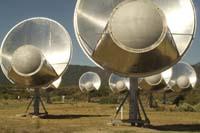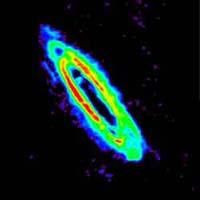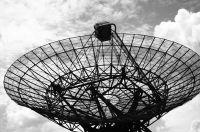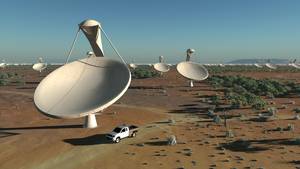Telescope network allen in search of alien
2007/10/20 Galarraga Aiestaran, Ana - Elhuyar Zientzia

These 42 are the first phase of a network of 350 radio telescopes. The entire network is called the Allen (ATA) telescope network and will function as a giant telescope. It is a project created by the Radioastronomy Laboratory of the University of California and the SETI Institute (Search for Extraterrestrial Intelligence, or the search for the alien dimen) and which has contributed the money necessary to take this first step one of the founders of Microsoft, Paul Allen.
The Allen telescope network aims to collect and interpret the radio waves of space. In fact, any object in space emits radio waves. These signals are very valuable to astronomers because they report the characteristics of the object: what it is, where it is, and many other details that cannot perceive the telescopes that work in the rest of wavelengths.
The radiotelescopes that existed until now were large telescopes or, if not, they were composed of approximately a dozen antennas connected to each other. By greatly embracing electronic gadgets, today it is cheaper to make many small antennas than to make a large one. And this is what the creators of the Allen telescope network have taken advantage of.
Each radio telescope has a diameter of six meters and a second receiver of 2.4 meters of diameter. All of them are dispersed at the California Radio Hat Creek Observatory. All together allow to observe a greater celestial surface than ever. In addition, it has the ability to immediately process the collected data, much faster than the previous radiotelescopes. They say that once the Allen telescope network has been completed, it will be possible to make a radiomapa of the entire sky in one day. In addition, they can hunt for events that only last a few hours, such as the collisions of black holes.
Slope of results

In addition to its speed, the Allen telescope network can operate in much of the spectrum of radio waves and simultaneously analyze four independent frequency bands. Therefore, you can perform various studies at once, for example, while searching for alien intelligence tracks, you can perform astronomical observations (or vice versa). According to SETI, the Allen telescope network will collect as many data as has been collected over the past 45 years in the next twelve years. Among all these data, it is expected to find artificially created signals by an intelligent being.
Apart from intelligent aliens, astronomers have already made the radio map of the Andromeda galaxy (M31), close to our galaxy, and the Hiruki galaxy (M33). From now on, they have several scientific objectives. Among other things, they want to measure the neutral hydrogen of galaxies located in three quarters of the sky, to know how many intergalactic gases are adding outer galaxies, so they expect to find black galaxies without stars.
On the other hand, they intend to classify radio sources that do not emit galaxies. At the moment, 250,000 sources have been found that, through their study, will allow astronomers to identify objects, quantify star formation, detect dark matter, and better understand the structure of the universe.

They also hope to discover phenomena as well known as black holes and which are not yet known. However, they are still in the first phase. Allen donated $11.5 million in 2001 to start the project and $13.5 million in 2003 to build the first phase. And now, in October 2007, they have launched it.
There are three more phases left. In fact, the objective is that 350 radio telescopes will be operational by 2010, but they estimate that they would need an additional $41 million. Although the last radio telescope built in the United States is half of what has cost, at the moment they do not have that money.
Therefore, it will not be surprising that in the coming months this project will appear in the media, since to raise funds it is always beneficial to have social support. One must see what will be based on to reach the public, on scientific objectives, or on the search for extraterrestrial intelligence. However, meanwhile, observatory astronomers will not be at rest and the data they will receive will probably be the best claim to attract investments.
Published in Gara

Gai honi buruzko eduki gehiago
Elhuyarrek garatutako teknologia






